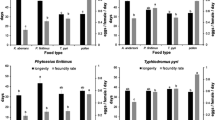Abstract
The predation preference of singly caged adult females and nymphs of Typhlodromus pyri and Kampimodromus aberrans for con- or heterospecific immature stages as prey was tested in the laboratory. Both polyphagous predatory mite species have been previously shown to interact directly through predation on each other. The present study demonstrated that the adult females of T. pyri and K. aberrans are able to discriminate between con- and heterospecific larvae and protonymphs and that they prefer to prey upon heterospecifics when given the choice. Hunger did not reduce the propensity of the females to prefer heterospecifics over conspecifics. For proto-and deutonymphs the trends followed the results obtained with the adult females, but the preference for heterospecifics was not distinct enough to be significant. In competitive situations reciprocal predation may be a crucial mechanism in the interaction of polyphagous phytoseiid species and may contribute significantly to population persistence. The results are discussed with regard to possible associations between the ability to discriminate con- and heterospecifics and the type of feeding specialization (generalists versus specialists).
Similar content being viewed by others
REFERENCES
Begon, M., Harper, J.L. and Townsend, C.R. 1996. Ecology: Individuals, Populations and Communities, 3rd edn. Blackwell Science, Oxford.
Croft, B.A. and MacRae, I.V. 1992a. Biological control of apple mites by mixed populations of Metaseiulus occidentalis (Nesbitt) and Typhlodromus pyri Scheuten (Acari: Phytoseiidae). Environ. Entomol. 21: 202–209.
Croft, B.A. and MacRae, I.V. 1992b. Persistence of Typhlodromus pyri and Metaseiulus occidentalis (Acari: Phytoseiidae) on apple after release and competition with Zetzellia mali (Acari: Stigmaeidae). Environ. Entomol. 21: 1168–1177.
Croft, B.A., Kim, S.S. and Kim, D.I. 1996. Intra-and interspecific predation on four life stage groups by the adult females of Metaseiulus occidentalis, Typhlodromus pyri, Neoseiulus fallacis and Amblyseius andersoni. Exp. Appl. Acarol. 20: 435–444.
Croft, B.A., Monetti, L.N. and Pratt, P.D. 1998. Comparative life histories and predation types: are Neoseiulus californicus and N. fallacis (Acari: Phytoseiidae) similar type II selective predators of spider mites? Environ. Entomol. 27: 531–538.
Duso, C. 1989. Role of the predatory mites Amblyseius aberrans (Oud.), Typhlodromus pyri Scheuten and Amblyseius andersoni (Chant) (Acari, Phytoseiidae) in vineyards. I. The effects of single or mixed phytoseiid population releases on spider mite densities (Acari, Tetranychidae). J. Appl. Entomol. 107: 474–492.
Helle, W. and Sabelis M.W. (eds) 1985. Spider Mites. Their Biology, Natural Enemies and Control, Vol. 1B. Elsevier, Amsterdam.
McMurtry, J.A. 1982. The use of phytoseiids for biological control: progress and future prospects. In Recent advances in knowledge of the Phytoseiidae, M.A. Hoy (ed), Agricultural Sciences Publications, University of California, Berkeley. pp. 23–48.
McMurtry, J.A. and Croft, B.A. 1997. Life styles of phytoseiid mites and their roles as biological control agents. Ann. Rev. Entomol. 42: 291–321.
MacRae, I.V. and Croft, B.A. 1993. Influence of temperature on interspecific predation and cannibalism between Metaseiulus occidentalis (Nesbitt) and Typhlodromus pyri Scheuten (Acari: Phytoseiidae). Environ. Entomol. 22: 770–775.
MacRae, I.V. and Croft, B.A. 1997. Intra-and interspecific predation by adult female Metaseiulus occidentalis and Typhlodromus pyri (Acari: Phytoseiidae) when provisioned with varying densities and ratios of Tetranychus urticae (Acari: Tetranychidae) and phytoseiid larvae. Exp. Appl. Acarol. 21: 235–245.
Monetti, L.N. and Croft, B.A. 1997. Neoseiulus californicus (McGregor) and Neoseiulus fallacis (Garman): larval responses to prey and humidity, nymphal feeding drive and nymphal predation on phytoseiid eggs. Exp. Appl. Acarol. 21: 225–234.
Park, T., Mertz, D.B., Grodzinski, W. and Prus, T. 1965. Cannibalistic predation in populations of flour beetles. Physiol. Zool. 38: 289–321.
Polis G.A., Myers, C.A. and Holt, R.D. 1989. The ecology and evolution of intraguild predation: potential competitors that eat each other. Ann. Rev. Ecol. Syst. 20: 297–330.
Schausberger, P. 1997. Inter-and intraspecific predation on immatures by adult females in Euseius finlandicus, Typhlodromus pyri and Kampimodromus aberrans (Acari: Phytoseiidae). Exp. Appl. Acarol. 21: 131–150.
Schausberger, P. 1998a. Juvenile survival and development in Euseius finlandicus, Typhlodromus pyri and Kampimodromus aberrans (Acari: Phytoseiidae) feeding on con-and heterospecific immatures. Exp. Appl. Acarol. 22: in press.
Schausberger, P. 1998b. Population growth and persistence when prey is diminishing in single-species and two-species systems of the predatory mites Euseius finlandicus, Typhlodromus pyri and Kampimodromus aberrans. Ent. Exp. Appl. in press.
Yao, D.S. and Chant, D.A. 1989. Population growth and predation interference between two species of predatory phytoseiid mites (Acarina: Phytoseiidae) in interactive systems. Oecologia 80: 443–455.
Zöfel, P. 1992. Statistik in der Praxis — 3. Auflage. Gustav Fischer Verlag, Stuttgart, Jena.
Author information
Authors and Affiliations
Corresponding author
Rights and permissions
About this article
Cite this article
Schausberger, P. Predation Preference of Typhlodromus Pyri and Kampimodromus Aberrans (Acari: Phytoseiidae) When Offered Con- and Heterospecific Immature Life Stages. Exp Appl Acarol 23, 389–398 (1999). https://doi.org/10.1023/A:1006172320540
Issue Date:
DOI: https://doi.org/10.1023/A:1006172320540



